The artist, the wanderer, the warrior. Vasily Vasilyevich Vereshchagin. 110 years from the date of death
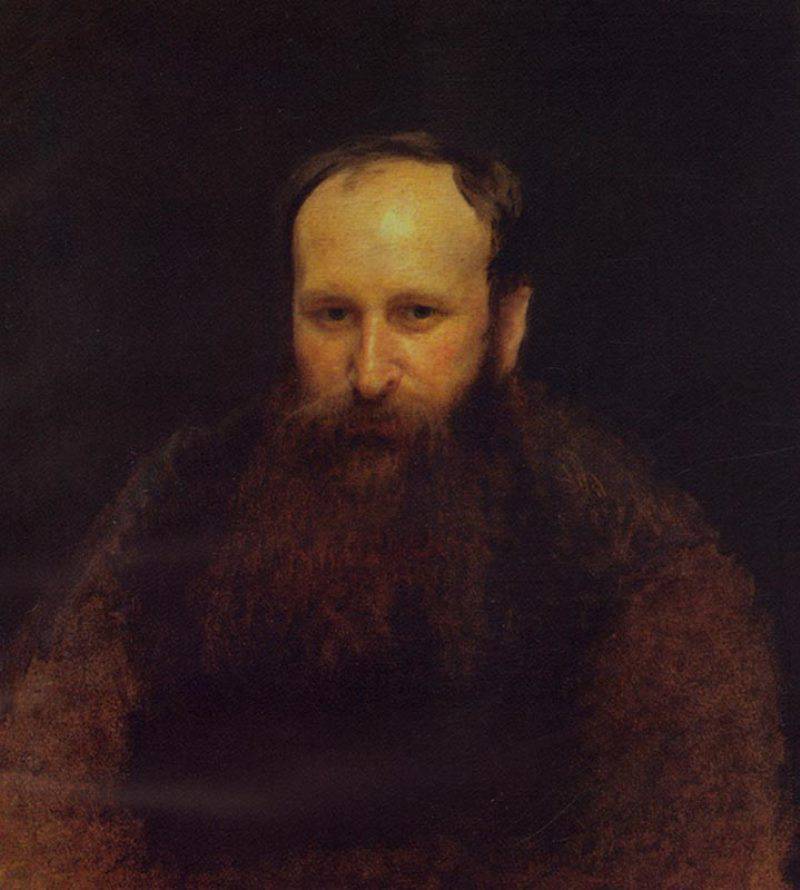
Vasily Vasilyevich was born in Cherepovets 14 in October 1842, in the family of a landowner. The first eight years of his life he spent on his father’s estate near Pertovka village. A large family of the future artist lived at the expense of serfdom and serf peasantry. And although Vereshchagin's parents were reputed to be relatively humane in the landlord environment, Basil himself often observed scenes of oppression of serfs and aristocratic arbitrariness. The impressionable boy painfully perceived the humiliation of people and the violation of human dignity.
At the age of eight, parents sent Vasily to the Alexander Cadet Corps for minors. The rules in the school during the time of Nicholas I were distinguished by coarse drill, cane discipline, despotism and heartlessness, which did not contribute to the desire of the Cadets to serve. It was during his studies that the main traits of Vereshchagin's character were revealed. He reacted keenly to any injustice or humiliation of a person. The estate arrogance and arrogance of the Cadets, favor with the students from the noble families of the leaders of the corps evoked a feeling of vehement indignation in Vereshchagin.
After graduating from the Alexander Cadet Corps, Vasily entered the Marine Corps in St. Petersburg. It should be noted that during the whole time of his studies, Vereshchagin was among the best students, and he graduated from the educational institution in the first place by the number of points. Here the growing will of the future artist was expressed, in the struggle for supremacy he had to sacrifice rest and entertainment, and regularly lack sleep. However, the knowledge gained, especially fluency in French, German and English, in the following years was very useful to him.
In 1860, Vasily Vasilyevich was promoted to midshipmen. Before him opened a brilliant career naval officer. However, while still studying at the Marine Corps, Vereshchagin was determined to become an artist. He had a desire to paint since childhood, and since 1858, he has regularly attended the school of the Society for the Encouragement of Artists. Vereshchagin's desire to leave the service ran into serious difficulties. First, his parents rebelled against this act in the most decisive manner. The mother said that painting lessons were demeaning for a representative of an old noble family, and her father promised to deny financial assistance to her son. And secondly, the naval department did not want to part with one of the most capable graduates of the Marine Corps. Contrary to the will of parents and chiefs, Vasily Vasilyevich left his military career, enrolling at the Academy of Arts in St. Petersburg in 1860.
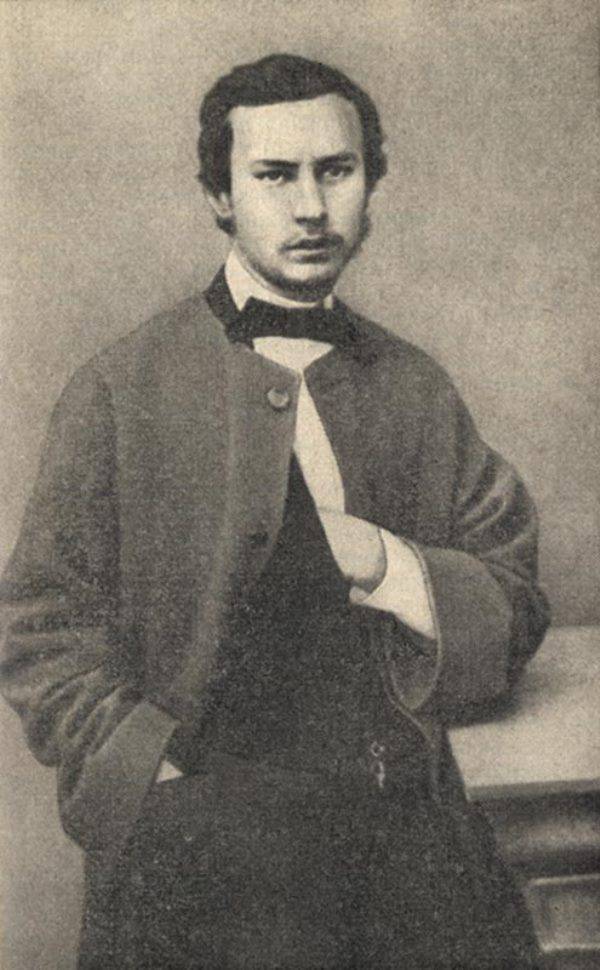
V.Vereschagin - student of the Academy of Arts 1860
The academic leadership immediately allocated the monetary subsidy, which was so necessary for Vereshchagin, and with all the spiritual fervor and diligence he devoted himself to his beloved work. Already in the first years of study, Vasily showed remarkable successes, his drawings regularly received encouragement and rewards. However, the longer Vereshchagin studied at the Academy, the stronger his dissatisfaction with local “studies” matured. The prevailing system of education was based on the traditions of classicism, which included the mandatory idealization of nature. Students in their works were supposed to refer to the themes of antiquity, religion and mythology. Even figures and events of national history were necessary to depict in an antique way. Meanwhile, the situation in Russia at that time was distinguished by the exceptional urgency of social and political life. The crisis of the feudal system escalated, a revolutionary situation arose. Autocracy was forced to prepare and implement peasant reform. Many vivid paintings, poems, dramatic works appeared in the country, exposing the unbearable living conditions of the urban poor and peasants. However, studies at the Academy of Fine Arts continued to be divorced from the advanced views of the era, which caused discontent among some members of the artistic youth, including Vereshchagin.
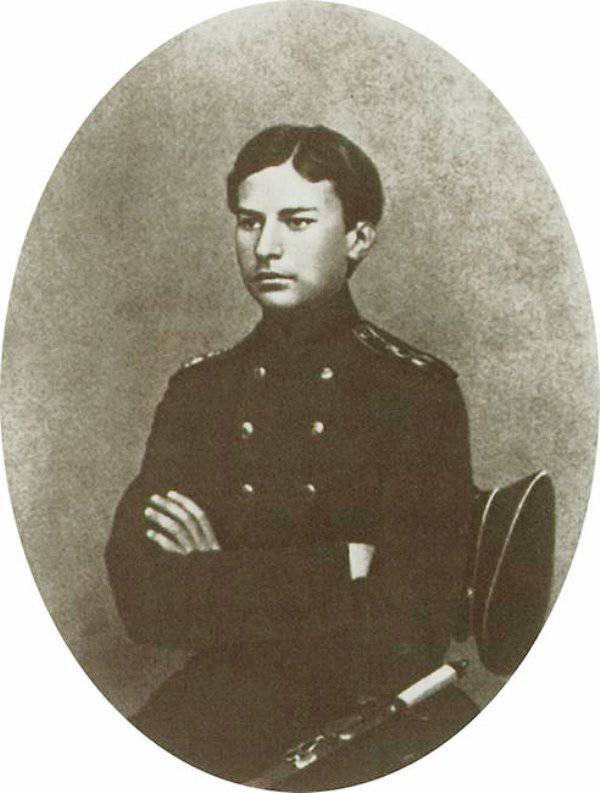
Vasily Vereshchagin during the period of graduation from the Naval Cadet Corps. Photo 1859 - 1860's
The democratic views of Vasily Vasilyevich, his commitment to realism strengthened and developed with each passing day. A study sketch of the artist on Homer's Odyssey was praised by the Academy Council, but the author himself was completely disappointed in the training system. He decided to do away with classicism in connection with which he cut and burned the sketch. Vereshchagin left the school in the middle of 1863, shortly before the famous “riot of fourteen” who created the independent Artel of artists.
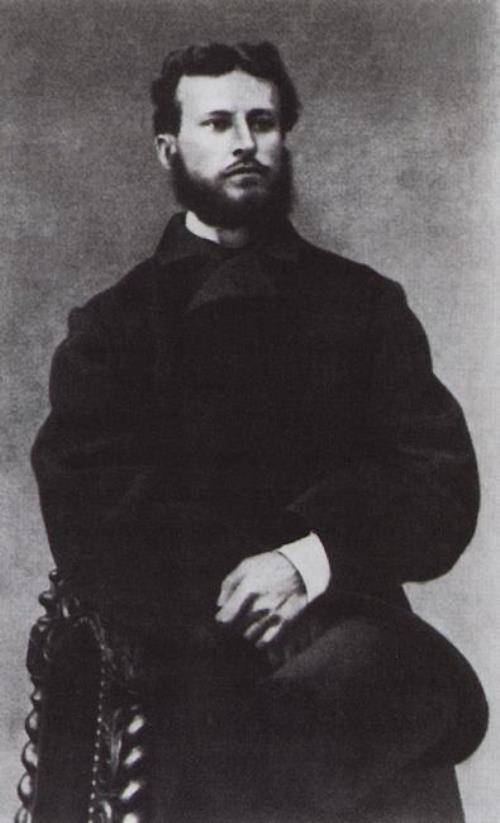
Vasily Vereshchagin during the first trip to the Caucasus
The young painter went to the Caucasus, eager to paint national images, scenes of national life and the southern nature unusual for his eyes. On the Georgian Military Road, Vasily Vasilyevich reached Tiflis, where he lived for over a year. He earned his bread by giving drawing lessons, and he devoted all his free hours to studying the peoples of Armenia, Georgia, Azerbaijan, trying to fix everything interesting and characteristic. True display of real life, making her "sentence" - that is what Vasily Vasilyevich began to see the meaning and purpose of art.
In those years, Vereshchagin worked only with pencil and watercolor, he did not have enough experience and knowledge to use oil paints. In 1864, his uncle died in Vereshchagin, the artist received a large inheritance and decided to continue his education. To this end, he went to France and entered the Paris Academy of Arts, starting internship with the famous artist Jean-Leon Gerome. Diligence and enthusiasm allowed Vasily Vasilyevich to achieve considerable success very soon. The Frenchman highly appreciated the talents of the new student, who, nevertheless, did not want to obey his instructions unquestioningly. Jerome offered endless sketches of antiques, advised to copy the paintings of the classics of painting. In fact, here the techniques of the St. Petersburg Academy of Arts were cultivated. Vereshchagin, however, attached importance only to work from nature. In the spring of 1865, he returned to the Caucasus. The artist recalled: "I escaped from Paris exactly from the dungeon, with some frenzy I began to draw in the wild." For six months, the young artist visited many places in the Caucasus, he showed particular interest in the dramatic stories of popular life.
The drawings of this period depict the savagery of local religious customs, denounce religious fanaticism, using ignorance and darkness of the people.
At the end of 1865, Vereshchagin visited St. Petersburg, and then again went to Paris, where he again eagerly began his studies. From Caucasian travels, he brought a huge number of pencil drawings, which showed Jerome and Alexander Bida, another French painter who took part in his training. Exotic and original pictures from the life of the peoples of little-known in Europe made a favorable impression on master-made artists. However, this was not enough for Vasily Vasilyevich; he wanted to present his work to a mass audience.
Throughout the winter of 1865-1866, Vasily Vasilyevich continued to persevere in the Paris Academy. For fifteen or sixteen hours the artist's working day lasted without rest and walking, without visiting concerts and theaters. The technique of his drawing has become more perfect and confident. He mastered and painting, closely embarking on work paints. The official training of Vereshchagin was completed in the spring of 1866, the artist left the Academy and returned to Russia.
Summer 1866 of the year Vasily Vasilyevich spent in the estate of his deceased uncle - the village of Lyubets, located in the Cherepovetsky district. Outwardly, the tranquil life of the estate, located near the Sheksna River, was broken by the bursting cries of burlatzian crowds pulling the merchants' barges. The impressionable Vereshchagin was struck by the tragic pictures seen in this place from the lives of ordinary people turned into pseudo-animals. Only in our country, according to the artist, has the burlam labor become a real disaster, having acquired a mass character. On this topic, Vereshchagin decided to paint a huge picture, for which he made sketches of barge haulers with oil paints, created sketches with a brush and a pencil — several burtyakh teams of two hundred fifty-three hundred people, following each other in a train of zugs. Despite the fact that, according to the plan, Vereshchagin’s canvas is significantly inferior to Repin’s famous painting “Barge Haulers on the Volga”, it is worth noting that Vasily Vasilyevich conceived the theme of the painting several years before Ilya Efimovich (1870-1873). In addition, the drama of the bourgeois fate, Vereshchagin, in contrast to Repin, tried to reveal not by psychological, but by epic means. A large-scale conceived work aimed at drawing public attention to one of the social ulcers of the then Russia was not completed. The inheritance ended, the artist had to give all his time and strength to random earnings. In the history of art forever remained only sketches and expressive sketches of barge haulers, created directly from nature.
In the middle of 1867, Vasily Vasilyevich set off on his new journey - to Turkestan. The artist wrote about the reasons that prompted him to leave the house: “I went because I wanted to find out that there is a real war, about which I heard and read a lot, near which I lived in the Caucasus.” At this time, active hostilities of the Russian army against the Emirate of Bukhara began. The events that took place interested Vereshchagin not at all from the side of tactics or strategy of battles, but only as a socio-political event, in the conditions of which the people of each of the warring parties struggle, live and suffer. At that moment, Vasily Vasilyevich did not yet have any anti-militarist convictions, no ideas and established opinions about the war. He was invited by the commander of the Russian troops Konstantin Kaufman and was with him in the rank of ensign.
Vereshchagin used the long journey to Tashkent and countless trips around Turkestan for eighteen months to write a series of sketches and drawings showing the life of the peoples of Central Asia; local fortresses, cities and towns; historical monuments. Vasily Vasilyevich carefully studied the customs, met people, visited inns, mosques, tea houses, bazaars. In his albums there were colorful types of Tajiks, Uzbeks, Kyrgyz, Kazakhs, Jews and Gypsies, as well as Persians, Afghans, Chinese and Indians who came across to him - people of different social status and age. At the same time, the artist noted the beauty of the southern nature, majestic mountains, fertile steppes, turbulent rivers. The series of sketches and drawings made by Vereshchagin at the end of 1860 represents a unique work, actually a vivid encyclopedia of the life and life of the peoples of Central Asia in the middle of the nineteenth century. At the same time, the technique of the artist himself has become more confident and impressive. The drawings have learned to transmit the most subtle lighting effects and light and shade transitions, they became distinguished by the maximum accuracy of relationship with nature. The artist's ability to work with oil paints has also increased.
In the middle of spring 1868, Vereshchagin learned that the Emir of Bukhara, who was in Samarkand, declared a “holy war” to Russia. Following the army, the artist rushed towards the enemy. Vasily Vasilyevich did not find the carnage that unfolded 2 on May 1868 of the year on the outskirts of Samarkand, but shuddered at its tragic consequences: “I have never seen the battlefield, and my heart was bleeding.” Vereshchagin stopped in the busy Russian troops Samarkand and began to explore the city. However, when the main forces under the command of Kaufman left Samarkand, continuing the fight against the emir, the city garrison was attacked by numerous troops of the Shahrisabz Khanate. The local population also rebelled, the Russian soldiers had to lock themselves in the citadel. The situation was disastrous, the opponents exceeded our strength eighty times. Vereshchagin had to change his brush to a gun and join the ranks of the defenders. With amazing courage and energy, he participated in the defense of the citadel, repeatedly led fighters into melee fights, participated in reconnaissance sorties. Once the bullet split the artist's gun, in the other - she knocked her hat off her head, besides, in the battle he was wounded in the leg. Coolness and courage created him a high reputation among the soldiers and officers of the detachment. Russian soldiers survived after the siege was lifted, Vereshchagin was awarded the St. George's Cross of the fourth degree. Vasily Vasilyevich constantly wore it. By the way, he decisively refused all subsequent awards.
Samarkand defense tempered the will and character of Vereshchagin. The horrors of battles, the sufferings and death of people, the views of the dying, the atrocities of the enemies who cut off prisoners of their heads — all this left an indelible mark on the artist’s mind, tormented and agitated him. In the winter of 1868, the artist visited Paris and then arrived in Petersburg. In the northern capital, Vereshchagin developed an active organization and holding of the Turkestan exhibition. Thanks to the support of Kaufman, the mineralogical, zoological, and ethnographic collections from Central Asia were exhibited in the city. Here Vereshchagin first presented a number of his drawings and paintings. The exhibition was a great success, the press started talking about the artist's works.
After the exhibition was closed, Vasily Vasilyevich again went to Turkestan, this time with Siberian roads. A trip through Siberia allowed him to see the difficult life of political exiles and convicts. In Central Asia, Vereshchagin constantly traveled, worked tirelessly. He traveled to Kyrgyzstan and Kazakhstan, traveled along the Chinese border, again visited Samarkand, visited Kokand. During the trips the artist repeatedly participated in battles with the robber gangs of the local sultans. And again, Vereshchagin showed extraordinary courage and courage, putting himself in mortal danger during hand-to-hand combat.
To summarize the material collected in Turkestan, the artist settled in Munich at the beginning of 1871. Constant exercises in the field of painting were not in vain. Now the artist was fluent in colorful harmony, sonorous colors easily and accurately conveyed the space and light-air environment. Much of the paintings, as before, the artist devoted to showing the life of Central Asia in the second half of the nineteenth century. The plots of other paintings were episodes of the war for the annexation of Turkestan to Russia. In these works with the incorruptible truth, the heroism of ordinary Russian fighters, barbarism and wildness of the customs of the Bukhara Emirate are conveyed.
The famous collector and philanthropist Pavel Tretyakov, visiting Munich, visited the studio of Vasily Vasilyevich. The works of Vereshchagin made a strong impression on Tretyakov, he immediately wanted to buy them. However, Vereshchagin wanted before the sale of paintings to organize a show to the public, to check their artistic and public beliefs. The exhibition of the Turkestan works of Vereshchagin was opened at the Crystal Palace in 1873 in London. This was the first individual exhibition of the artist. Works surprised viewers. Unusual and new in content, powerful and expressive in artistic and realistic form, ripping with the conventions of salon-academic art. The British public had a great exhibition, and for the Russian artist in general an unprecedented success. Magazines and newspapers published commendable reviews.
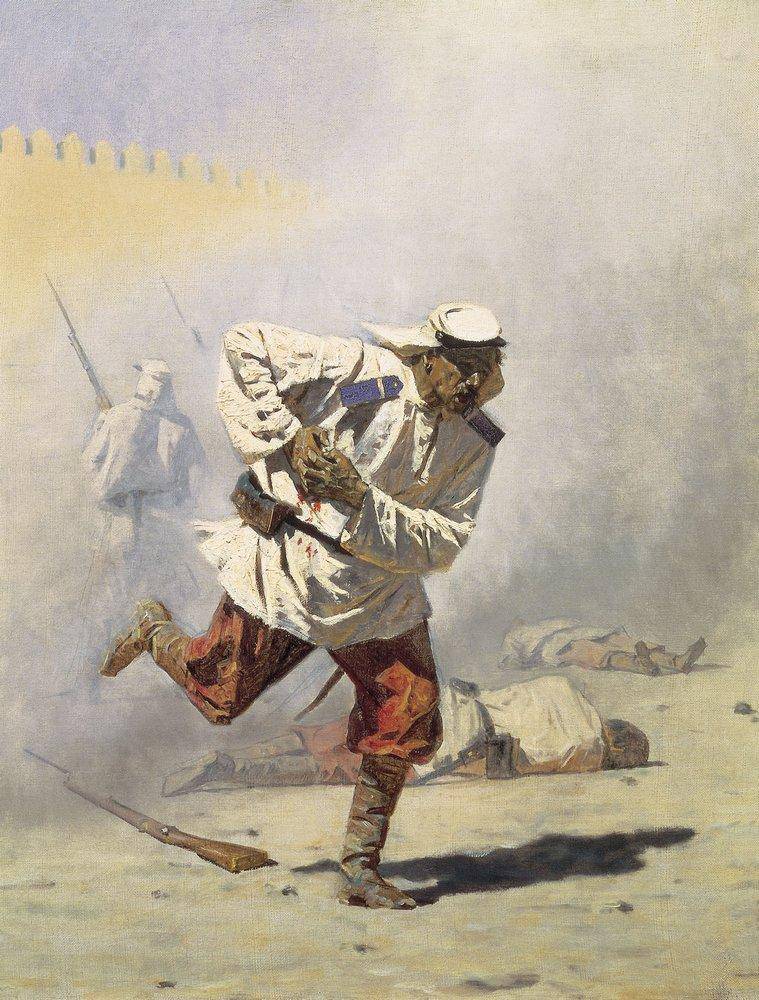
Mortally wounded, 1873
At the beginning of 1874, Vereshchagin presented Turkestan paintings in St. Petersburg. To attract the underprivileged public, he set free entry for a few days a week. And this exhibition was a great success, provoking lively responses from leading figures of Russian culture. Mussorgsky based on the plot of one of the paintings by Vereshchagin wrote the musical ballad “The Forgotten”, and Garshin composed a passionate poem about unknown warriors who died in this war. Kramskoy wrote: “This is something amazing. I do not know whether the artist currently exists, equal to him in our country or abroad. ”
However, the royal dignitaries, along with the higher generals, reacted negatively to the paintings, finding their content slanderous and false, defaming the honor of the Russian army. And this was understandable - in fact, until that time, the battleists depicted only victories of the tsarist troops. It was very difficult for generals to come to terms with the episodes of defeats shown by Vereshchagin. In addition, in presenting in his paintings the historical epic of the annexation of Turkestan to Russia, the audacious artist never immortalized either the reigning emperor or even one of his generals. Shortly after the exhibition began, the ruling circles launched a real persecution of its organizer. Articles began to appear in the press accusing Vasily Vasilyevich of anti-patriotism and treason, of a “Turkmen” approach to events. The sale of reproductions of paintings by Vereshchagin was not allowed, even the Mussorgsky ballad was banned.
Under the influence of unfair and outrageous accusations, Vereshchagin, in a state of nervous breakdown, burned three of his beautiful paintings, which caused special attacks by dignitaries. However, the conflict between him and government circles continued to intensify. He was accused of lying, represented as a troublemaker and a nihilist. They recalled certain episodes of the artist’s biography, for example, how he refused to serve on navy, arbitrarily left the Imperial Academy of Arts. The Turkestan series in general was an open challenge to the tradition of presenting military-historical events consecrated for centuries.
The atmosphere of persecution became so unbearable for Vereshchagin that he, without becoming determined to determine the fate of his Turkestan canvases, left St. Petersburg before the exhibition closed, going on a long journey through India. Already after he gave the task to the trustee to sell this series, subject to the purchaser of several mandatory conditions, such as: preserving the paintings in the homeland, their availability to the public, the inseparability of the series. As a result, the Turkestan work bought Tretyakov, placing them in his illustrious gallery.
With the departure of Vasily Vasilyevich from Russia, his conflict with government circles did not subside. The new impetus was the demonstrative refusal of Vereshchagin, who was in India, from the professorship of the Academy, which was awarded to him in 1874 by the Imperial Academy of Arts. Vereshchagin explained his refusal by the fact that he considers all awards and titles in art unnecessary. A number of artists of the Academy took this as a personal insult. The severity of the situation was that the Academy of Arts, which was essentially one of the court institutions, headed by members of the imperial family, was in a deep crisis at that time. Cultivating the outdated views of late classicism, the Academy has lost its credibility. Many advanced artists of Russia moved away from it. Public refusal Vereshchagin even more dropped the prestige of this government institution. Discussion of the act of Vasily Vasilyevich in the print media authorities tried to drown out. It was forbidden to publish articles criticizing the Academy and all the more expressing solidarity with Vereshchagin.
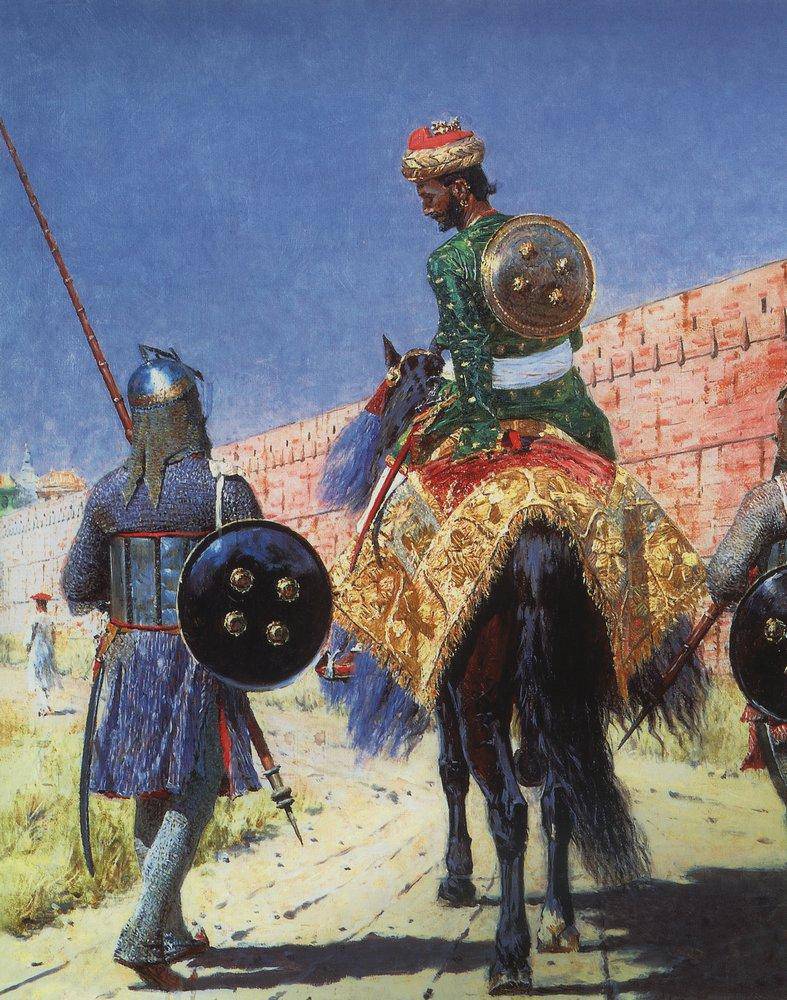
Warrior Rider in Jaipur. About 1881
In India, the artist lived for two years, visited many areas, traveled to Tibet. At the beginning of 1876, he returned to France, and in 1882-1883 he traveled around India again, because the materials collected during the first trip were not enough. As in his previous travels, Vereshchagin carefully studied popular life, visited cultural and historical monuments. He worked Vasily Vasilyevich sparing neither health nor strength. He had the opportunity to repel the attacks of wild animals, to sink in the river, to freeze on the mountain tops, to recover from severe tropical malaria. The culmination of the Indian cycle was the accusatory film "The Suppression of the Indian Uprising by the British", showing the most brutal shooting scene of the recalcitrant Indian peasants by the English colonialists.
At the beginning of 1877, the Russian-Turkish war began. Upon learning of this, the artist immediately threw down his paintings in Paris and went into the army. Without official content, but with the right of free movement, he was among the adjutants of the commander-in-chief of the Danube army. Vasily Vasilyevich took part in a number of battles, witnessed many battles. Every free minute he grabbed a pencil and paints, he often had to work under Turkish bullets. To the questions of friends about why he voluntarily participates in battles and risks his life, the artist replied: “It’s impossible for society to give pictures of real war, looking at the battle through binocular ... to know cold, hunger, wounds, diseases ... One should not be afraid to sacrifice one's meat and blood, otherwise the pictures will be “not that”.
8 June 1877 of the year, participating on the Danube as a volunteer in the attack of a small torpedo boat against a huge Turkish ship, Vasily Vasilyevich was seriously wounded and almost died. Not yet recovered, the artist rushed to Plevna, where Russian troops stormed the stronghold for the third time. The Battle of Plevna became the basis of a number of famous paintings by the artist. At the end of the war at the headquarters of Commander-in-Chief Vereshchagin they asked what award or order he would like to receive. "Of course, no!" - The artist replied. The Russian-Turkish war brought him great personal grief. His beloved younger brother, Sergei, died, and another brother, Alexander, was badly injured. The trouble for Vereshchagin was also the loss of about forty of his etudes. This happened because of the negligence of a number of persons whom he instructed to send work to Russia.
The Balkan series of Vereshchagin is the most significant in his work both in artistic mastery and in his ideological content. It portrays the unspeakable torment, hard work and terrible calamities that war brings to the masses of people and nations. In connection with the opening of the Vereshchagino exhibitions in the press in 1880 and in 1883 in St. Petersburg, a lot of articles appeared supporting the artist: solemn processions. All that fascinating, ceremonial atmosphere, which mankind invented to cover the most disgusting of its acts, is unfamiliar to the artist's brush, there is only naked reality in front of you. ” Interest in the Vereshchaginsky paintings in society was unusually high. In private homes, clubs, in theaters and on the streets there was a lively discussion. Critic Vladimir Stasov wrote: “Not all the paintings of Vereshchagin are equal - he has both weak and mediocre ones. Although where was the artist who, in a number of works, all had only pearls and diamonds of the highest caliber? This is an unthinkable thing. But who in Russia does not feel the greatness of the Vereshchagin exhibition, which has nothing similar not only in our country, but also in the whole of Europe? The best of their current painters of war are still far from our Vereshchagin for courage and the depth of realism .... In terms of technology, in terms of expression, in thought, in sense, Vereshchagin had not yet risen so high. Only the one who is completely devoid of artistic sense and feeling does not understand this. ”
Nevertheless, the authorities still accused the artist of anti-patriotism, of sympathizing with the now Turkish army, of deliberately discrediting the Russian generals. There were even proposals to deprive Vasily Vasilyevich of the title of St. George's Gentleman, arrest and send him into exile. By the way, not only in our country, but in Europe, and later in America, the ruling circles feared the accusatory, anti-militarist influence of the Vereshchagin paintings. For example, the artist later wrote from the USA: “I was told about the offer to take children to the exhibition at a low price, that my paintings can turn young people away from war, which, according to these“ gentlemen ”, is undesirable.” And to the journalist’s question about how famous modern commanders relate to his works, Vereshchagin answered: “Moltke (Helmut von Moltke - the greatest military theorist of the nineteenth century) adored them and was always the first at exhibitions. However, he issued an order forbidding soldiers to see pictures. He allowed the officers, but not the soldiers. ” To the collapsed criticisms of some military that Vereshchagin in his works too thickens the tragic sides of the war, the artist replied that he did not show even a tenth of what he observed in reality.
Due to heavy emotional experiences, Vasily Vasilyevich developed a serious nervous breakdown, which led to internal doubts. In a letter to Stasov in April, 1882, he said: “There will be no more battle-like pictures - that's that! I take my work too close to my heart, I cry out the sorrow of everyone killed and wounded. In Russia, in Prussia, in Austria they recognized the revolutionary orientation of my military scenes. Well, let not the revolutionaries draw, but I will look for other plots. ” In 1884, Vasily Vasilyevich went to Palestine and Syria. After the trip, he created a series of paintings on scenes of the Gospel that were absolutely unusual for him. However, the artist interpreted them in a very original way, quite different from the traditions adopted in European art. It is necessary to add that Vereshchagin was a materialist and an atheist, he did not believe in supernatural miracles and mysticism. As a result of much deliberation, he tried to materialize the Gospel legends, which the church recognized as real sacrilege. The Catholic clergy were terribly “offended” by the pictures: the archbishops wrote whole appeals against them, groups of fanatics were searching for the artist, wanting to settle scores with him, and one monk poured acid and almost the Holy Resurrection pictures on him. In Russia, all the Gospel paintings of Vasily Vasilyevich were banned.
In 1890, the artist's dream of returning home came true. He settled in a new house on the outskirts of the capital, however, he lived there for a very short time, going on a trip to Russia. As in his youth, he was interested in monuments, life of the population, nature, folk types, Old Russian applied art. Among the paintings of the Russian cycle (1888-1895), the most outstanding are the portraits of the “unremarkable Russians” - the faces of ordinary people from the people.
In the 1887 year, Vasily Vasilyevich embarked on a new monumental series devoted to the Patriotic War 1812 of the year. Twenty canvases created by him showed a truly magnificent, full of patriotic pathos epic about the Russian people, about their national pride and courage, hatred for conquerors and devotion to the Motherland. Vereshchagin did a gigantic research work, studied many of his contemporaries' memories and historical materials written in different European languages. He personally explored the field of the Battle of Borodino, acquainted with the relics of the era, created a lot of sketches and sketches. The fate of the 1812 series of canvases has remained unsolved for many years. Designed for large palace halls and museums paintings did not deceive private patrons. The government looked at the new works of Vereshchagin with hostility and distrust, also stubbornly refusing to buy all the paintings at once, and the artist did not agree to sell one or two of the whole and indivisible series. Only on the eve of the centenary anniversary of the Patriotic War, under the pressure of public opinion, the tsarist government was forced to purchase canvases.
At the end of his life, Vasily Vasilyevich made a number of long journeys. In 1901, the artist visited the Philippine Islands, in 1902 - in Cuba and the USA, in 1903 - in Japan. Unusually picturesque Japanese studies have become a new stage in the work of Vereshchagin, testifying to his tireless work on the development of skill. The artist's trip to Japan was interrupted by a deteriorating political situation. Fearing to be interned, Vereshchagin left the country in a hurry and returned to Russia.
In his speeches, he warned the government about the impending war, but as soon as it began, the sixty-two-year-old artist considered it his moral duty to go to the front. Vereshchagin left his beloved wife and three children at home and went into the thick of military actions in order to tell people the whole truth about the war again, to show its true nature. He died along with Admiral Stepan Makarov 31 March 1904, while on board the flagship "Petropavlovsk", flown on Japanese mines. It was the death of a post in the full sense of the word. Miraculously, Captain Nikolai Yakovlev, who was saved during the Petropavlovsk catastrophe, said that before the explosion, he had seen Vasily Vasilyevich recording the sea panorama on his album.
The death of Vereshchagin caused a response worldwide. Magazines and newspapers printed articles about his life and work. At the end of 1904, a large posthumous exhibition of paintings by the artist opened in St. Petersburg, and a few years later a museum was built in Nikolaev in his name. Vasily Vasilyevich became one of the first who managed in the fine arts to express the idea that war should not and cannot be a means of solving international conflicts. He believed that education and science are the main engines of progress. All his life he remained the fierce enemy of "barbarism", despotism and violence, a defender of the oppressed and dispossessed. Ilya Repin said about Vereshchagin: "The personality is colossal, truly heroic - super artist, superman."
Based on materials from the site http://www.centre.smr.ru
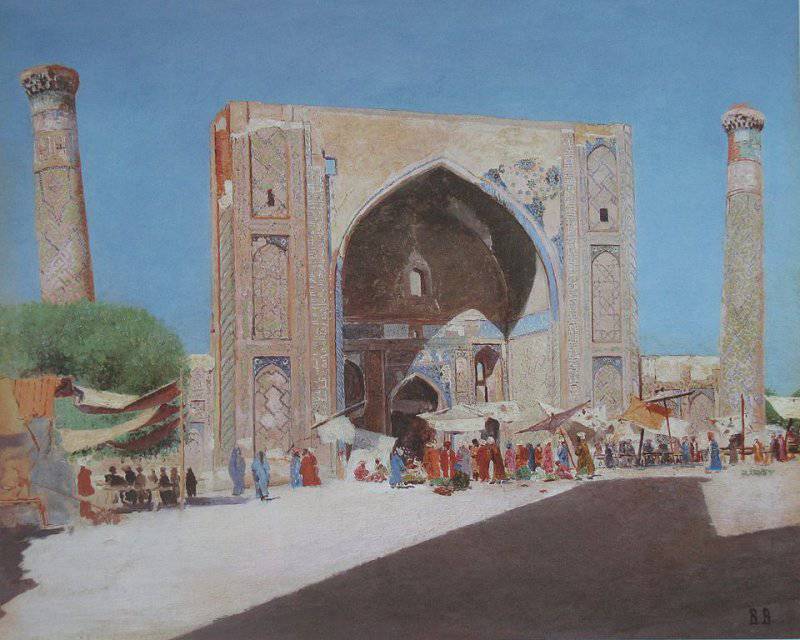
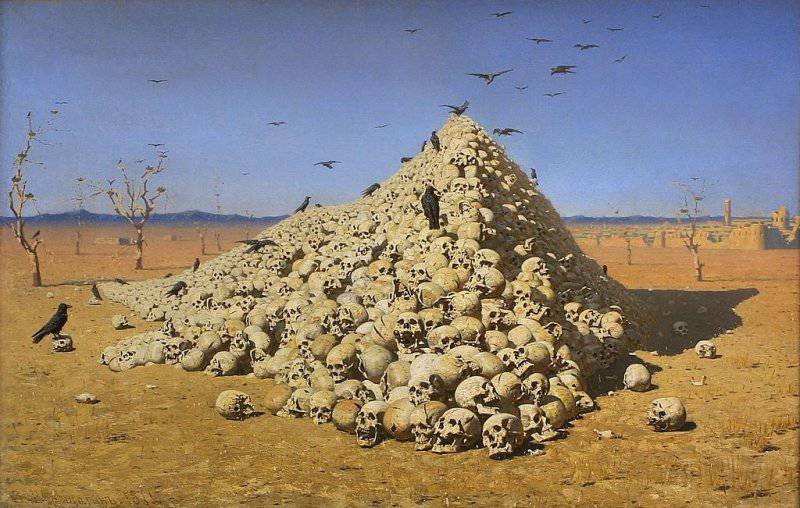
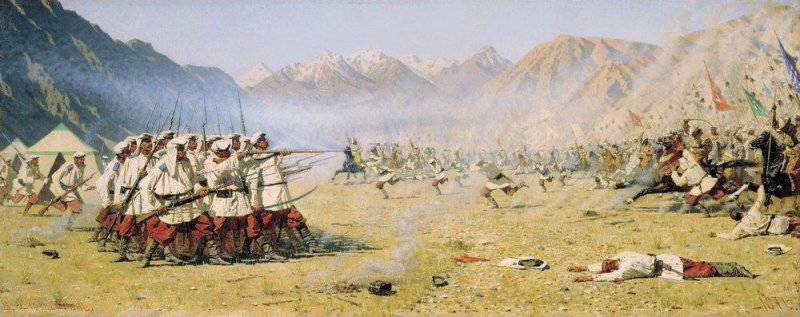
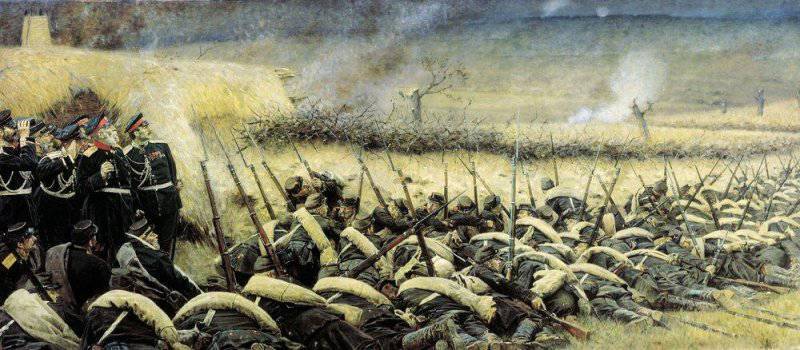
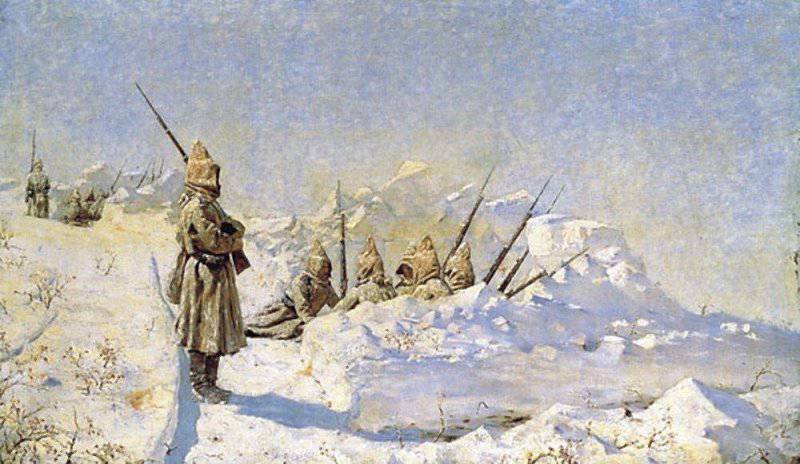
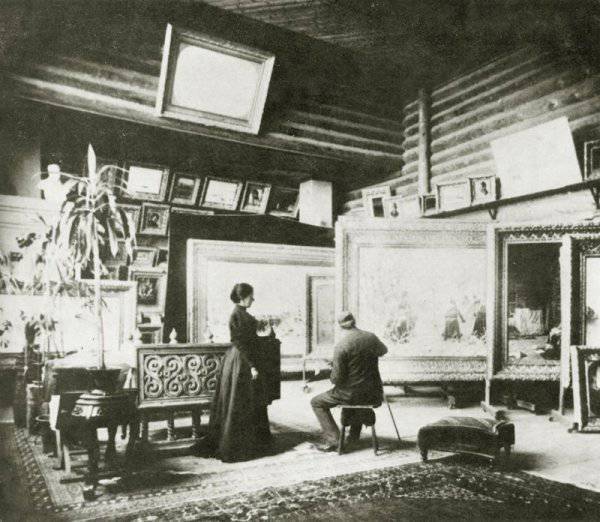
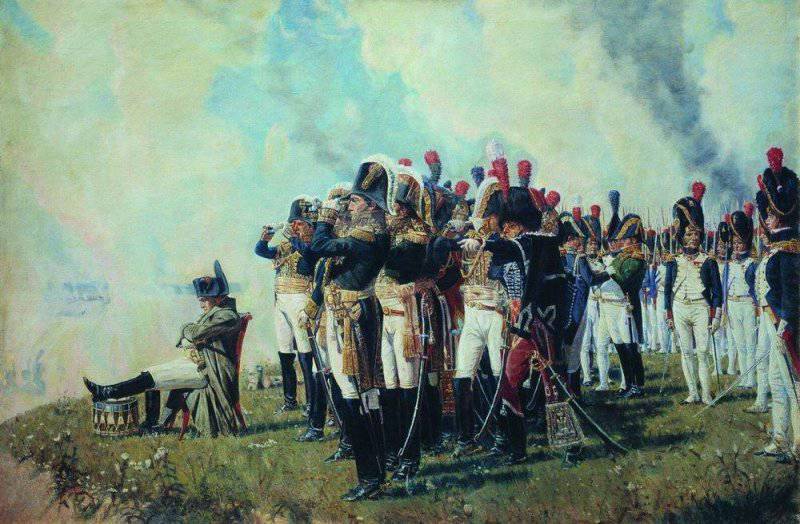
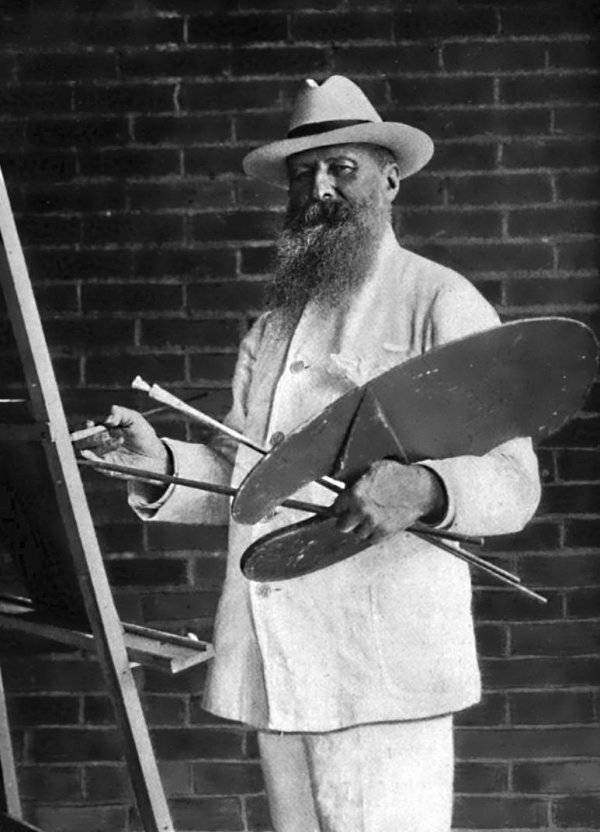
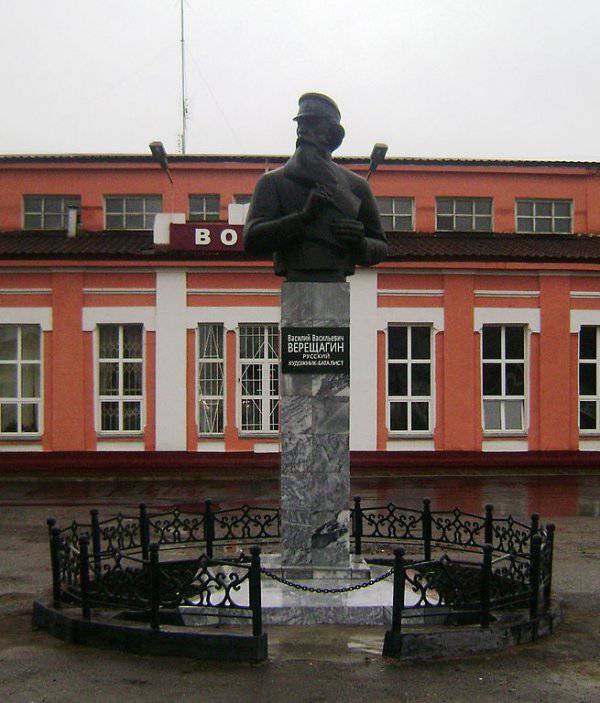
Information